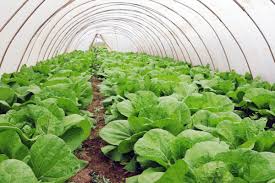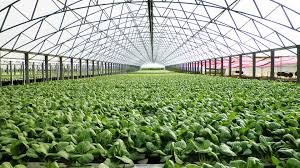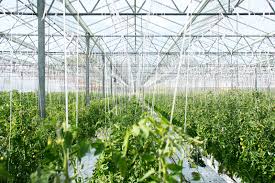Protected cultivation is a technique wherein the microclimate in the surrounding area of the plant is controlled partially or fully or modified to protect the crop from weather, especially very low or high temperatures, hailstorms, and heavy rains.
This technology is also useful for protecting the plants from birds, insects, etc., and conserving the soil moisture simultaneously.
Protected cultivation of vegetables offers distinct advantages of quality, productivity, and favorable market price to the growers.
Protected cultivation is a unique and specialized form of agriculture. Devices or technologies for protection (windbreaks, irrigation, soil mulches) or structures (greenhouses, tunnels, row covers) may be used with or without heat.
Protected cultivation enables some control of wind velocity, moisture, temperature, mineral nutrients, light intensity, and atmospheric composition.
The purpose of protected cultivation is to grow crops where otherwise they could not survive by modifying the natural environment to prolong the harvest period, often with earlier maturity, to increase yields, improve quality, enhance the stability of production, and make commodities available when there is no outdoor production.
The primary emphasis is on producing high-value horticultural crops (vegetables, fruit, flowers, woody ornamentals, and bedding plants).
Vegetable growers can substantially increase their income by protected cultivation in off-season under low plastic tunnels.
Walk-in tunnels are also suitable and effective to raise off-season nursery due to their low initial cost. Insect-proof net houses can be used for virus-free cultivation of tomato, chili, sweet pepper, and other vegetables mainly during the rainy season.
These low-cost structures are also suitable for growing pesticide-free green vegetables. Poly trenches have proved extremely useful for growing vegetables under cold desert conditions in upper reaches of the Himalayas.
Read Also: How to Grow, Use and Care for Whiteedge Flatsedge Grass (Cyperus flavicomus)
Background, Definition, and Objectives of Protected Cultivation in Agriculture

1. Background of Protected Cultivation in Agricultural Practices
Protected cultivation is a process of growing plants in a controlled environment. This means that the temperature, humidity, light, and other factors of the environment can be regulated as per the requirement of the crop to assist in the production of healthier and larger produce.
In addition, protected agriculture can be described as the cultivation of high-value vegetables and other horticultural crops in greenhouses.
This system of farming allows the cultivation of cash crops on small plots in marginal, water-deficient areas where traditional cropping is not viable.
Protected cultivation, also known as controlled environment agriculture (CEA), is highly productive, conservative of water and land, and also protective of the environment.
The growth and yield of vegetables in an open-field are faced with many environmental constraints such as heavy rain, thunderstorms, excessive solar radiation, temperatures and humidity levels above plant growth optima, high insect pest infestation pressure, and fungal diseases.
Thus, protected cultivation is being used to mitigate and control the adverse effect of the environment.
Protected cultivation enables the producer to control climate (temperature, humidity, wind, and light intensity, etc.), atmospheric gas composition (mainly CO₂ concentration), fertilization, watering, pests and diseases, etc., which results in better plant growth, better reproduction, minimized harmful effects of different factors such as climate and agronomy, and higher production with a better quality of produce.
The technology was originally developed and tested by ICARDA in the Arabian Peninsula, and it has been adapted and successfully used in smallholder farming systems in Afghanistan, Pakistan, and Yemen.
2. Definition and Objectives of Protected Cultivation in Crop Farming
Protected cultivation practices can be defined as a cropping technique wherein the microenvironment surrounding the plant body is controlled partially or fully as per plant need during their period of growth to maximize the yield and resource saving.
Protected cultivation can also be briefly defined as cropping techniques in which the microclimate surrounding the growing plant is controlled partly or completely, as per the requirement of the plant species.
3. The objectives of protected cultivation of vegetables, fruits, herbs, and flowers are:
1. Protection of plants from abiotic stress (physical or by the non-living organism) such as temperature, excess or deficit water, hot and cold waves, and biotic factors such as pest and disease incidences, etc.
2. Efficient water use with minimum weed infestation.
3. Enhancing productivity per unit area.
4. Minimizing the use of pesticides in crop production.
5. Promotion of high-value, quality horticultural produce.
6. Propagation of planting material to improve seed germination percentage, healthy, uniform, disease-free planting material, and better hardening.
7. Year-round and off-season production of flower, vegetable, and fruit crops.
8. Production of disease-free and genetically better transplants.
Read Also: How To Grow, Use and Care For Threeawn Grass (Aristida Spp.)
Production Systems (Media and Components) of Protected Cultivation

1. Media for Protected Cultivation
Protected cultivation systems can be classified based on the type of growing media used for plant production. Each system is selected depending on crop requirements, local conditions, and cost-effectiveness.
These systems differ mainly in the way water and nutrients are supplied to the plants. The major media used in greenhouse production include:
2. Soil System / Ground Culture / Geoponics
This is the traditional method where crops are grown directly in the ground soil within a protected structure. The existing soil is improved with organic matter and nutrients to support crop growth.
This system is cost-effective and suitable for small-scale farmers but may have challenges such as uneven nutrient distribution and pest build-up if not well managed.
2. Soilless Culture / Hydroponics
Plants are grown without soil, using nutrient-rich water solutions. This system provides precise control over nutrient and water supply, leading to higher productivity and faster growth.
It includes systems like nutrient film technique (NFT), deep water culture, and aeroponics. Though highly productive, hydroponics requires technical knowledge and higher initial investment.
3. Substrate Culture
In this method, plants are grown in inert media such as coco peat, perlite, vermiculite, or rockwool. The media support plant roots and supply water and nutrients through drip irrigation.
This system reduces soil-borne diseases, allows better root aeration, and improves water use efficiency. However, it needs careful monitoring and regular nutrient management.
4. Aquaponics
This is a combination of aquaculture (raising fish) and hydroponics. Fish waste provides nutrients for plant growth, and plants help filter and purify the water for the fish.
It is an environmentally friendly system that maximizes resource use, but it requires precise balancing of the aquatic and plant systems.
5. Aeroponics
In this advanced system, plant roots are suspended in air and misted with a nutrient solution. It allows maximum oxygen exposure to roots, promoting faster growth and higher yields. However, it is highly technical, costly, and mainly suited for research or high-value crops.
6. Components of a Protected Cultivation Structure
To ensure successful plant growth in protected environments, several key structural and functional components are required. These include:
i. Frame structure – Supports the protective covering; made from galvanized iron pipes, bamboo, or wood depending on durability and cost.
ii. Cladding material – Covers the structure to regulate sunlight, temperature, and humidity; materials include UV-stabilized polyethylene, polycarbonate sheets, or shade nets.
iii. Ventilation systems – Includes natural or forced ventilation (fans and exhausts) to maintain optimal internal temperature and air exchange.
iv. Irrigation and fertigation units Automated drip or misting systems that deliver water and nutrients directly to the root zone, improving efficiency.
v. Cooling and heating systems – Fans, foggers, or pad-and-fan systems used to cool the structure during hot periods; heaters used during cold weather.
vi. Shading systems – Internal or external shade nets that reduce solar radiation and prevent crop wilting during extreme heat.
vii. Sensors and control panels – Modern structures may include automated systems with temperature, humidity, and soil moisture sensors to regulate environmental conditions.
viii. Pathways and beds – Clearly marked pathways and raised beds allow better access and prevent soil compaction.
ix. Pest exclusion nets – Installed to prevent the entry of insects, thus reducing pest incidence and need for chemical sprays.
x. Support structures – Used to train climbing or tall crops like tomatoes, cucumbers, and capsicum for better space utilization and air circulation.
Do you have any questions, suggestions, or contributions? If so, please feel free to use the comment box below to share your thoughts. We also encourage you to kindly share this information with others who might benefit from it. Since we can’t reach everyone at once, we truly appreciate your help in spreading the word. Thank you so much for your support and for sharing!

